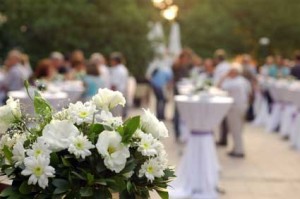Wedding Reception Tradition
 The wedding reception is a party held after a wedding ceremony. When the ceremony is over, it is customary for the newlywed couple to invite guests who attended the wedding ceremony to a reception. But where does this tradition come from? No matter what cultural or religious tradition, the wedding reception represents the community’s affirmation of the new couple.
The wedding reception is a party held after a wedding ceremony. When the ceremony is over, it is customary for the newlywed couple to invite guests who attended the wedding ceremony to a reception. But where does this tradition come from? No matter what cultural or religious tradition, the wedding reception represents the community’s affirmation of the new couple.
Weddings have always been celebrations of the unity of two people through a religion or a civil institution. Although customs vary across the world, most cultures would always organize a gathering after a wedding ceremony. These receptions would range from a small meal to a mighty feast provided for guests. For the most part, however, these gatherings were held at the bride’s family’s house or the house of worship where the ceremony took place. By the Industrial Revolution, when aristocracies and the rich became more affluent in the U.S. and Europe, the wedding receptions began to take place in public venues. The venues could accommodate larger parties and became more lavish and elaborate. Over time, more and more people were able to invest in public receptions hosting family, friends, and members of the community. However, tradition has remained the same regarding receptions: it is a time for the newlyweds to thank the community and family members for attending the ceremony and affirming their marriage.
Diverging Traditions
There are cultural differences in how receptions are organized, and many of these traditions are rooted in religions and cultures. For example, in Judaism, a wedding is a mitzvah, a religious commandment rooted in the Talmud. Tradition and particular customs have evolved across the existence of Judaism to make the reception both a holy and festive event. The wedding ceremony begins when braided bread, known as the challah, is given to the groom. The groom then leads the reception with a prayer over the bread. Then the seudah mitzvah begins, which is the traditional Jewish meal observed during holy ceremonies. Some Jewish communities perform the Horah, where the bride and the groom sit in chairs that are then lifted by strong guests. The reception ends when the birkat hamazon is said, which is the concluding prayer for a festive celebration. Overall, this type of a wedding reception affirms tradition and religious significance from holy texts.
Islamic wedding receptions vary since Islam crosses into many cultures across Africa and Eurasia. Generally, a Muslim wedding is the unification of the couple as equals, and the wedding ceremony reflects a civil tradition and commitment rooted in the Qur’an. After a Muslim couple has signed the marriage contract, known as the meher, the wedding reception can begin. The reception, called a walima, can sometimes last for two days depending on the local customs and the couple’s wishes. The reception allows for family, friends, and the community to celebrate the unified couple and to bless them with a fertile future. This often includes various symbols of fertility, such as almonds or eggs being presented as gifts to the couple. Overall, this wedding reception affirms the unified couple and their desire to start a family.
A Christian wedding reception is similar to a conventional Western ceremony. This is because of the interconnected nature between the development of Western culture and Christianity in Europe and the Americas. However, various Christian denominations may present religious symbolism, language, and ceremony more vocally in the reception. Spiritually, the wedding ceremony and reception in Christianity are public acknowledgments of the couple’s unification toward Jesus Christ. A Christian reception may include song and prayer. Conservative Christian denominations may minimize or shun alcohol at the reception completely. Overall, this form of a wedding reception affirms the unity of the couple under Christ.




